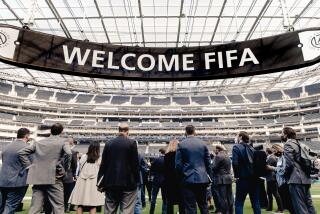City Should Keep Steady Course for Cup Defense
- Share via
Dennis Conner’s sensational America’s Cup victory has served as the starter’s cannon for the next big competition, over which American city will be host for the cup defense three years from now. In the preliminaries for that event--the challenge round, if you will--each area must decide how much it is willing to spend and do to be selected.
As the hometown of Conner and the Sail America syndicate, San Diego seems to have the inside track. The executive director of Sail America has said he believes San Diego has an 80% chance of landing the defense. But strong bids also are expected from San Francisco, Hawaii, Rhode Island and perhaps Long Beach and New Orleans.
There is a point of view that holds yacht racing to be a big-bucks, somewhat obscure sport that not even a majority of seaside residents can relate to, and therefore the community should not go all out to land its most sacred event. But this town runs on tourism, and the America’s Cup defense would be a fantastic tourist event. A 1985 study, done by Chapman College for an Orange County-based sailing syndicate, predicted that a cup defense in Newport Beach would have a $1-billion impact on the Southern California economy, mainly in Orange County.
It would be shortsighted to argue that no public funds should be spent on securing the cup defense. Not only would the event return many times the investment during each year of the competition, but it would enhance San Diego’s position throughout the world as a tourist destination.
However, the City of Los Angeles showed in 1984 when it staged the Olympic Games that, through creative use of corporate sponsorships, a successful international sporting event can be staged without large expenditures of public funds. In Los Angeles, the city spent no money for which it was not reimbursed, though the state and federal governments did incur some costs.
There are obvious differences in the Olympics and the America’s Cup, of course. One is that the type of surtax on ticket sales that raised millions of dollars for Los Angeles would not be applicable here. But San Diego has the estimable resource of the Unified Port District, whose considerable cash reserves give it the ability to pay for many of the facilities that would be necessary to accommodate 30 or so competing syndicates and hundreds of journalists.
Though no official moves have been made yet, several port commissioners have indicated a willingness to get behind the cup defense. Two have been in Australia as part of a San Diego fact-finding team.
It is appropriate that the Port District play a lead role in San Diego’s cup defense package. But it’s also important that the mayor, City Council, County Board of Supervisors and the community wholeheartedly get involved in pursuing the event. The investment now could continue to reap benefits for years to come, as a successful staging of the cup defense in 1990-91 could lead to the competition being held here many times in the future.
The America’s Cup may not have the same broad appeal locally of a World Series or Super Bowl, but economically it could be much bigger. It’s simply too good an opportunity for San Diego not to go all out in pursuit of it.
More to Read
Go beyond the scoreboard
Get the latest on L.A.'s teams in the daily Sports Report newsletter.
You may occasionally receive promotional content from the Los Angeles Times.










